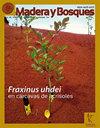Performance of mycelium composites of Lentinus crinitus under two compression protocols
IF 0.4
4区 农林科学
Q4 FORESTRY
引用次数: 3
Abstract
Considering the current environmental problems that has been generated by the excessive production of synthetic plastics, more sustainable alternatives have been proposed. One of these recently studied materials are the mycelium composites, a product obtained with lignocellulosic particles agglomerated together by the myceliar growth of a filamentous fungus. This novel type of materials could represent an option to replace non-biodegradable materials. In this work, mycelium composites with characteristics comparable to expanded polystyrene (EPS) and potentially suitable for fabrication of insulation panels were developed using a Lentinus crinitus strain previously selected after mycelial phases tests. Mechanical variables in bending, compression strength and stiffness were measured following ASTM D143 standard. Two protocols for composite fabrication were followed using different compression loads. Flexural strength reached 0.48 MPa and compression strength 0.235 MPa. Results obtained were compared with data of balsa wood (Ochroma pyramidale) for the similarity of possible applications, expanded polystyrene as its possible substitute and early published data on mycelium composites. Mechanical performance in flexural and compressive strength of the obtained materials revealed their potential use as biodegradable alternatives to some applications of synthetic plastics as insulation panels and packing materials.两种压缩条件下香菇菌丝复合材料的性能研究
考虑到目前合成塑料的过度生产所造成的环境问题,人们提出了更可持续的替代品。最近研究的材料之一是菌丝复合材料,这是一种由丝状真菌的菌丝生长而成的木质纤维素颗粒凝聚在一起的产品。这种新型材料可以替代不可生物降解的材料。在这项工作中,菌丝复合材料的特性可与发泡聚苯乙烯(EPS)相媲美,并可能适用于制造隔热板,使用事先经过菌丝阶段测试后选择的香菇菌株开发。按照ASTM D143标准测量弯曲、抗压强度和刚度等力学变量。采用不同的压缩载荷,采用两种方案制备复合材料。抗折强度达到0.48 MPa,抗压强度达到0.235 MPa。将得到的结果与轻木(Ochroma pyramidale)的数据进行了比较,以确定其可能应用的相似性,并将膨胀聚苯乙烯作为其可能的替代品,以及早期发表的菌丝复合材料的数据进行了比较。所获得的材料在弯曲和抗压强度方面的机械性能显示了它们作为合成塑料的一些应用的可生物降解替代品的潜在用途,如绝缘板和包装材料。
本文章由计算机程序翻译,如有差异,请以英文原文为准。
求助全文
约1分钟内获得全文
求助全文
来源期刊

Madera Y Bosques
FORESTRY-
CiteScore
0.90
自引率
0.00%
发文量
16
审稿时长
>12 weeks
期刊介绍:
Madera y Bosques (Wood and Forests) is a scientific periodical journal which has the objective of serving as media for scientific and technological research related to forest products, forest management and conservation as well as forest ecology topics and related subjects. It publishes original scientific papers, topical articles, scientific notes or bibliographic reviews. It is a quarterly publication that appears in Spring, Summer and Fall. Ocassionally, special Winter Issues are published. Manuscripts are accepted in Spanish, English and sporadically in other languages. It has no Page Processing Charges and it is published by the Environment and Sustainability Department of the Instituto de Ecología, A.C. (Xalapa, Ver., México).
 求助内容:
求助内容: 应助结果提醒方式:
应助结果提醒方式:


